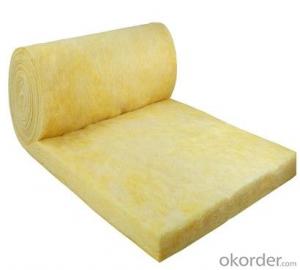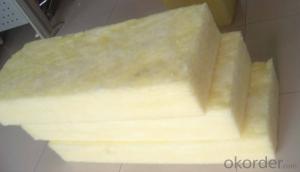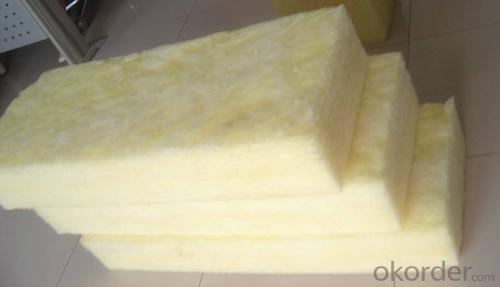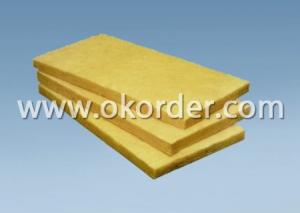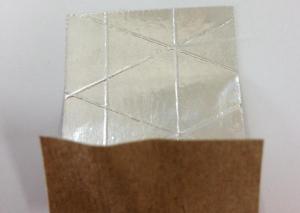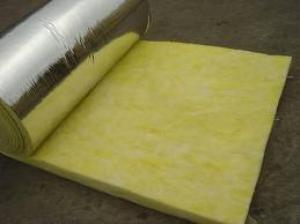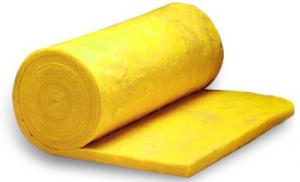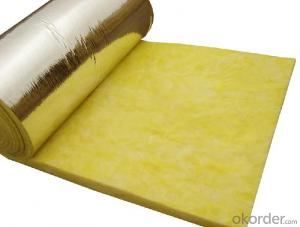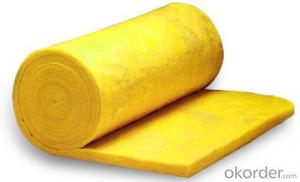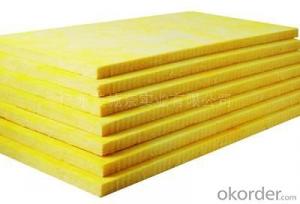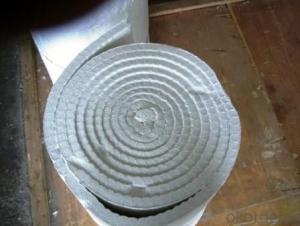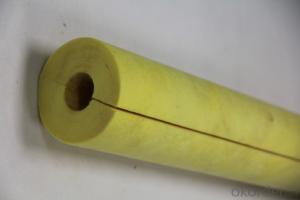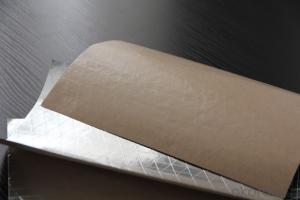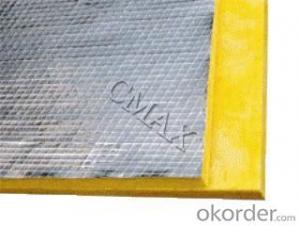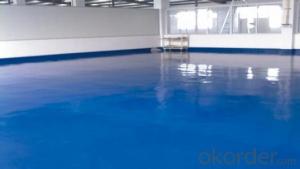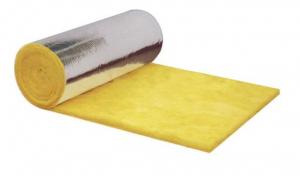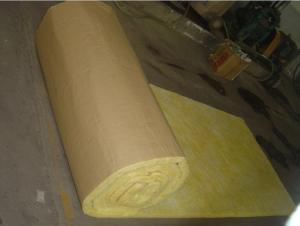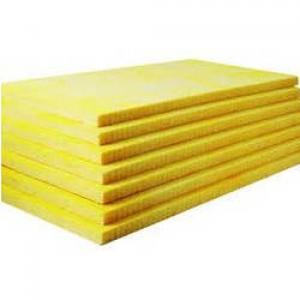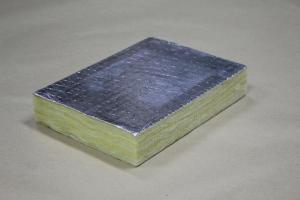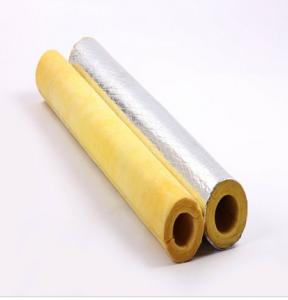Aluminum Foil Faced Glass Wool Insulation - Factory Direct
- Loading Port:
- Tianjin
- Payment Terms:
- TT OR LC
- Min Order Qty:
- 1000 roll
- Supply Capability:
- 100000 roll/month
OKorder Service Pledge
OKorder Financial Service
You Might Also Like
Glass Wool Insulation Price
INTRODUCTION
In the field of insulation materials, weare mainly specializing in Glass wool products, including blankets, boards andpipes. The advantage of this material is numerous: noncombustible, nontoxic,and resistant to corrosion. It has low weight, low thermal conductivity, stablechemical property, low moisture rate and good hydrophobicity. These productshave been widely used in heat preservation, thermal insulation and soundabsorption in construction, chemical industry, electronic industry, electricpower, metallurgy, energy industry, and communication. High density panelslaminated with facing can be used for Air-conditioning duct system.
The Kinds of Glass Wool Insulation
* glass wool blanket plain or with Aluminum foil -clad(Kraft paper or white PVC/WPSK)
* glass wool board
* glass wool pipe
Our Advantage
* Short delivery time
* Origin of China, FROM A / E/ F
* Stable good quality with competitive price (CE certificate)
TECHNICAL DATA
Item | Unit | Index |
Density | Kg/m3 | 10-100 |
Average Fiber Diameter | μm | 5-7 |
Water Content | % | ≤1 |
Grade of Combustibility | Non-Combustible Grade A | |
Reshrinking Temp | ℃ | ≥250 |
Thermal Conductibility | w/m.k | 0.038-0.06 |
Hydrophobic | % | ≥98 |
Moisture Rate | % | ≤5 |
Noise Resistant Coefficient (NRC) | 0.75 | |
Slag Inclusion Content | % | ≤0.3 |
CE CERTIFICATE
Glasswool Blanket
Introduction
The glass wool blanket is applied for largelaying area. Besides the character of thermal insurance, it also has theperformances of shock absorption and acoustical isolation, especially for middleor low frequency sound. It also can cancel the noise and improve workingenvironment.
The glass wool blanket with aluminum foilsurface has good capability of heat radiation protection.
TechnicalData
Item | Unit | Index |
Density | Kg/m3 | 10-32 |
Thickness | mm | 25-150 |
Width | mm | 600-1200 |
Length | mm | 10000-30000 |
Note: Product with special specificationcan be made to order.
Both unfaced and faced felts can beprovided.
Application
This material can be freely cut inconstruction according to the shape required, mainly used in room,noise-canceling system, transportation, refrigerators and household electricappliances for noise canceling.
The blanket with aluminum foil is suitablefor high temperature shops, control room, inner wall of the machine shops, roomseparating and inner liners.
Package
Normal packing: Each roll is wrapped withvacuum plastic bag, and then in PE woven bag.
Special required package like PE BAG and PESHRINKED BAG can be made with additional charge.
Glasswool Pipes
Introduction
As this material has the characters ofwater-proof, anti-corrosion and mildewing-proof, glass wool pipe is good atstopping condensation and freezing of the pipes.
TechnicalData
Item | Unit | Index |
Density | Kg/m3 | 48-96 |
Thickness | mm | 25-90 |
Diameter | mm | 18mm-529mm(3/4 inch to 21 inch) |
Length | mm | 1 000,1 200 |
Note: Product with special specificationcan be made to order.
Both unfaced and faced felts can beprovided.
Application
It is widely used in building, heating powerpipes, air conditioning and refrigerators for thermal insurance, such as hotwater pipes, steam pipes, electric power, petroleum and chemical industries.
Glass wool pipe faced with Alum Foil can beapplied to the surface for preventing moisture and radiation.
Package
Reasonable pieces will be packed withplastic bags or carton box, and then into container.
Glasswool Boards
Introduction
Glasswool board is a kind of plate productwith fixed strength after hot-setting of the centrifugal glass wool. It hasexcellent thermal insurance performance in the environment of both high and lowtemperature.
TechnicalData
Item | Unit | Index |
Density | Kg/m3 | 24-96 |
Thickness | mm | 20-100 |
Width | mm | 600-1 200 |
Length | mm | 1 200,2 400 |
Note: Product with special specificationcan be made to order.
Both unfaced and faced felts can beprovided.
Application
It is mainly used for the partition wall inthe high-grade building, such as ceiling, air conduit and inner wall forthermal insurance, machine shops for noise absorption, and metal ceiling forcontrol of moisture.
High density panels with laminated facingcan be used for Air-Conditioning Duct System.
Package
Reasonable pieces will be packed withplastic bags, and then into container.
- Q: Does curtain wall glass wool belong to thermal insulation wool?
- In general, the outer wall heat preservation material should be distinguished with curtain wall thermal insulation material, curtain wall thermal insulation material is commonly mineral wool, and exterior insulation materials commonly uses polystyrene board, waterproof mortar and other composite materials.
- Q: Glass fiber, glass wool, what is the difference
- Glass wool is the fibrous glass fiber, the formation of cotton-like material, chemical composition of glass, is a kind of inorganic fiber. Has a good shape, small density, thermal conductivity, thermal insulation, sound-absorbing performance, corrosion resistance , Chemical stability.
- Q: What are the differences between glass asbestos and glass?reinforced?plastics?
- Asbestos also known as "mountain cloth" is a commercial term that refers to silicate mineral products with high tensile strength, high flexibility, heat resistance, and chemical corrosion, electrical insulation as well as spinnability. It is the general term of natural fibrous silicate minerals. It includes two categories, a total of six kinds of minerals(serpentine asbestos, hornblende asbestos, actinolite asbestos, antholite asbestos, amosite asbestos, tremolite asbestos, etc.) Asbestos are made of fiber bundles, while fiber bundles are composed of long and narrow fibers which can be separated from each other. Asbestos, with properties of highly fire resistance, electrical insulation and thermal insulation, are important fireproofing, electrical insulation and thermal insulation materials. Glass?reinforced?plastics(FRP) also known as GRP, are fiber-reinforced plastics which generally refers to the matrix of glass fiber reinforced unsaturated polyester, epoxy resin and phenolic resin. Reinforced plastics, with glass fiber or its products as reinforced materials, refer to glass fibre reinforced plastics or glass?reinforced?plastics. Due to the different varieties of resin, there are polyester glass?reinforced?plastics, epoxy glass?reinforced?plastics, and phenolic aldehyde glass?reinforced?plastics. They are light and rigid, non-conducting, and corrosion-resistant. They have high mechanical strength, low recycling rate. Machine parts, cars and Ship hulls made of steel can be replaced by them.
- Q: Whether the rock wool is belong to the glass wool product or not.
- the manmade inorganic fiber is made by the high-speed centrifugation equipment. it molding is good. the different rock wool thermal insulation products has different requirements, and it can be made into different specification and the material of the cotton-shaped is the inorganic substance fiber with stable chemical performance. Glass wool is melten glass fibrosis, it is corrosion resistance, and man-made inorganic fiber, while adding a special binder and dust?laying?oil, low bulk density, good sound absorption, thermal insulation, low thermal conductivity. Glass wool belongs to a category in glass fiber, chemical composition belongs to glass, melting in high temperature! the specific defination is in the following rock wool is taken the natural basalt as the main raw material. the two names are different but the thermal insulating and refractory material performance is nearly the same.
- Q: What is the difference between anti-high temperature glass wool and ordinary glass wool?
- High-temperature glass wool is made of lathy glass fibers without shot. Compared with other kinds of insulation materials, it will not be broken due to water or rain, and it can still remain its insulation properties unchanged after drying in the sun (Thermal insulation materials have hydrophobicity which doesn’t mean that the materials are not hydrophilic but means that the discharge capacity for absorbed moisture). High-temperature glass wool is a thermal insulation material that can resist high temperature with its lightweight, lasting durability and excellent thermal insulation property, the material that is made up of uniform and slender and elastic glass fibers as well as special high-temperature adhesive. The outer protective layer of thermal insulation structure can use galvanized iron sheet based on specific circumstances. Application of high-temperature glass wool: It is widely used in equipment and pipelines of electric power, petroleum, chemical industry, light industry, metallurgy and other industries, serving as the thermal insulation.
- Q: How to fix centrifugal glass wool felt for steel structure?
- Fix with pins
- Q: As for glass wool board and rock wool board, which kind of material is better?
- Glass wool has light unit weight, thin fiber, good sound absorption, rock wool fireproofing performance, good hydrophobic performance, low price, both two have their advantages, it depends on the specific usage, If you are interested in it, we can discuss with each other, personal opinions for reference only.
- Q: does the glass wool can be used as building materials?
- Of course, it can be used as steel structure roofing thermal insulation and also be used as pipe thermal insulation. it can also be used as the central air-conditioner air duct. It belongs to the inorganic insulation material, and widely used in construction.
- Q: What is the difference between high density glass wool board and stereoplasm rock wool board?
- Centrifugal glass wool uses glass as the main raw material. Glass mixed with a certain percentage of other materials should be fully melted in the glass furnace. The melted solution will flow out of bushing and enter into the centrifuge.In the high speed centrifuge, glass will be thrown into a glass thin stream. Under the effect of high temperature and high speed flame, glass thin stream is further stretched into fibers and sprayed with foggy adhesive. In the effect of negative pressure wind cotton webs, the fibre with resin adhesives falls on mesh belt, forming a homogeneous cotton blanket and then it is solidified in thermostat curing oven. After the shape of it is fixed, the glass wool will become predetermined products after cut and then be packed.The main raw material of rock wool products is fine basalt rock. The basalt rock is made into inorganic fiber after meited under high temperature and processed in the high-speed centrifugal device. Then the arrangement structure of the fibre is changed after it is add with special binder and dust laying oil and put in a special device. In the last step, the product is solidified and become a new lightweight thermal insulation material. Depending on the application, it can be processed into wool board, rock wool blanket and wool shell.Compared with rock wool, glass wool is of lower unit weight, less shot content, lower thermal conductivity, long service life and high tenacity fiber, rock wool. However, the maximum operating temperature of rock wool is about 600 degrees Celsius while the glass wool is only about 260 degrees Celsius.Glass woolwool is generally used in thermal insulation part less than 200 degrees Celsius and is mainly used for thermal insulation in general buildings or low temperature pipes. Rock wool is generally used at thermal insulation part with the temperature of 500 degrees Celsius and is mainly used for heat perservation of of high temperature heat pipes or electrical equipment.
- Q: What is the main use of glass wool insulation materials?
- rubber and plastic are good insualtion and low temperature resistance while glass wool is fire resistant and high-temperture resistant.
Send your message to us
Aluminum Foil Faced Glass Wool Insulation - Factory Direct
- Loading Port:
- Tianjin
- Payment Terms:
- TT OR LC
- Min Order Qty:
- 1000 roll
- Supply Capability:
- 100000 roll/month
OKorder Service Pledge
OKorder Financial Service
Similar products
Hot products
Hot Searches
Related keywords
